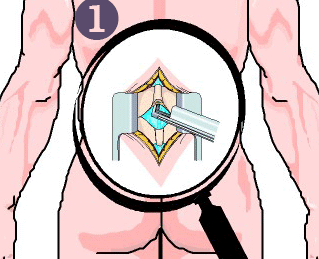Medical Library
Pick a Body Area
Lumbar Laminectomy/Discectomy

A lumbar laminectomy/discectomy is a common surgery to remove fragments of an extruded herniated disc. The image above is a simplification of the procedure:
- The surgeon makes an incision through the skin just off the centerline of the spine. The bony area of the vertebra, called the lamina is exposed and a small portion of it is removed (called a laminectomy).
- A ligament, called the ligamentum flavum, is reflected back to expose the nerves and the extruded disc material.
- The spinal nerve is retracted (moved back) for better exposure of the extruded disc fragments. The fragments are then removed (this is called a discectomy or removal of the damaged disc fragments).
Physical therapy should be prescribed after surgery. While rehabilitation for each individual can differ, treatment usually consists of flexibility exercise, lumbar stabilization/core strengthening, and aerobic exercise. Studies have shown that patients that undergo physical therapy after lumbar discectomy have better outcomes than those that do not receive physical therapy.
Possible Treatments
- Core Strengthening Video
- Cryotherapy or Cold Therapy Video
- Electrotherapeutic Modalities
- Gait or Walking Training Video
- Isometric Exercise Video
- Low Back Active Range of Motion Video
- Low Back Joint Mobilization Video
- Low Back Passive Range of Motion Video
- Low Back Resistive Range of Motion Video
- Physical Agents
- Soft Tissue Mobilization Video
- Core Strengthening
Possible Treatment Goals
- Improve Fitness
- Improve Function
- Improve Muscle Strength and Power
- Increase Oxygen to Tissues
- Improve Proprioception
- Decrease Postoperative Complications
- Improve Range of Motion
- Self-care of Symptoms
- Improve Safety
- Improve Tolerance for Prolonged Activities
- Improve Wound Healing
Additional Resources
Disclaimer
The information in this medical library is intended for informational and educational purposes only and in no way should be taken to be the provision or practice of physical therapy, medical, or professional healthcare advice or services. The information should not be considered complete or exhaustive and should not be used for diagnostic or treatment purposes without first consulting with your physical therapist, occupational therapist, physician or other healthcare provider. The owners of this website accept no responsibility for the misuse of information contained within this website.
